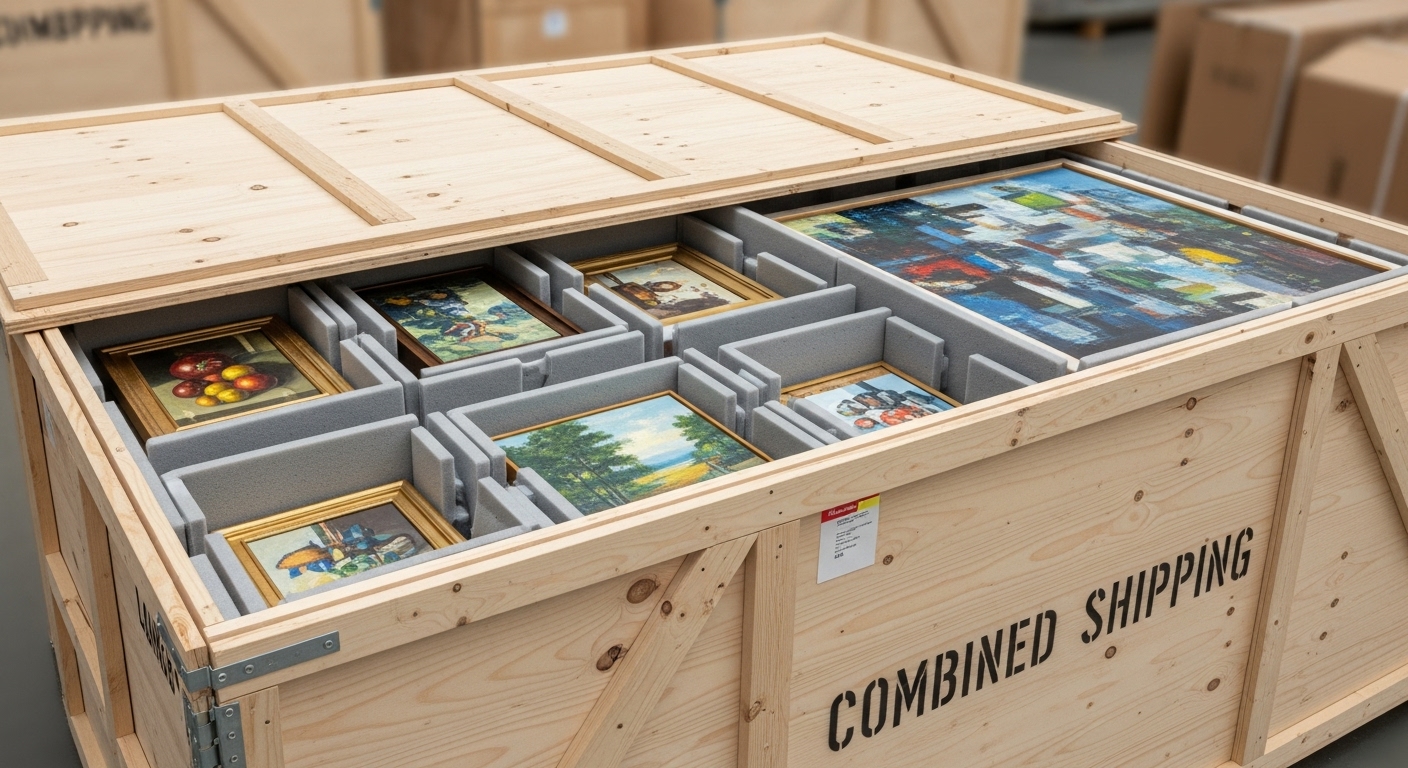How Artists Can Optimize the Cost of International Shipping for Their Works

For many artists, international delivery of paintings is not a luxury, but a necessity: orders from collectors, participation in exhibitions and fairs, collaboration with galleries abroad. But as soon as the question arises how to send a painting abroad from Ukraine, dozens of practical issues appear: how much will it cost, which method to choose, how to avoid overpaying for packing, insurance and storage.
The good news is that the cost of international delivery of paintings abroad can be optimized without sacrificing quality, and sometimes you can cut total expenses by 20–40%. To do this, you need to understand what the price consists of, which shipping options actually work in practice, and where artists most often overpay.
In this article, we’ll break down how to build a smart strategy so you can send a painting abroad safely, legally, and without unnecessary spending.
Why International Shipping of Paintings Can Be Expensive
Key factors that affect the shipping price
When an artist first deals with international shipping, the cost of delivery of paintings can look unreasonably high. But if you break the price into components, it becomes clearer. Usually, the final rate is influenced by:
- dimensions and weight of the package (not just of the painting itself);
- destination country and distance from Ukraine;
- type of shipment - post, courier, or specialized art logistics;
- declared value and insurance;
- need for customs clearance and documents related to cultural property;
- extra services: storage, repacking, door-to-door delivery.
The larger and heavier the box, the higher the declared value, the more complex the route - the higher the cost. That’s why the question “how to send a painting abroad” profitably starts not with choosing a carrier, but with understanding what exactly you are sending and how it is packed.
How the shipping method (post, courier, art logistics) changes the cost
There are three main approaches:
- National or international postal services.
- Commercial courier services.
- Specialized art logistics companies.
Postal services often look like the cheapest option, but are not always suitable for large or very expensive works. Couriers offer speed and tracking, but may have hidden surcharges. Art logistics seems expensive, but sometimes it is the best balance between cost and safety - especially for valuable paintings.
How to Choose the Right Shipping Method to Save Budget
Postal services: when it’s beneficial for an artist
The question “how to send a painting by post abroad” comes up for most artists who are just starting to work with international buyers. Post can indeed be a very economical option if:
- the painting is small, or it’s a work on paper rolled into a tube;
- the value of the work is moderate;
- the buyer is ready to wait standard delivery times;
- you’ve packed the work properly and are ready to accept the risks of postal shipping.
It’s especially important to understand how to send a painting by post abroad from Ukraine if you work with small formats and prints. In such cases, post is a truly reasonable compromise between cost and functionality, provided that the packing and paperwork are done correctly.
Courier services - pros, cons and hidden fees
Courier companies provide control and convenience: tracking, SMS notifications, and door-to-door delivery. But you must factor in:
- surcharges for “non-standard” dimensions;
- fees for remote delivery areas;
- possible customs charges billed to the recipient;
- insurance cost tied to declared value.
Often the base rate looks fine, but once all surcharges are added, the total grows significantly. So when planning delivery of paintings abroad, you should read the terms carefully and confirm whether all fees are included in the quoted price.
Specialized art logistics: when it really makes sense
Art logistics is the right choice when you work with expensive, large, or particularly fragile pieces. These companies account for temperature, humidity, vibration, and take care of professional packing and insurance.
Yes, this option is more expensive, but when you deal with unique works headed to serious exhibitions or auctions, it is not “overpayment”, but protection of an asset. Sometimes it is cheaper to pay once for professional delivery of painting with proper packing and insurance than to repair your reputation and argue with an insurer after damage.
How to Optimize Packing and Reduce Its Cost
Which materials you can use without compromising protection
Packing is not only about safety - it directly influences cost. You pay for the volume and weight of the parcel. To optimize spending, try to find balance:
- use sturdy cardboard and foam instead of heavy wooden crates where possible;
- avoid unnecessary layers that add bulk but little protection;
- choose lightweight yet shock-absorbing materials.
A useful question for any artist: can this work be packed so that it is protected but the dimensions remain minimal? Sometimes smart packing is the main answer to how to send a painting abroad cheaper without risking damage.
When a tube is enough and when you need a hard box
A tube is great for graphics, posters, and prints, but not for a canvas on stretcher. It’s important to distinguish:
- an original on stretcher or framed - flat packing only, with corner and surface protection;
- prints and posters - can be rolled and sent by post abroad in a tube, significantly reducing parcel size.
Once you understand how to send a painting by post abroad in print format, you’re already saving money: postal services usually offer better rates for compact cylindrical packages than for large flat boxes.
How to reduce parcel size and avoid overpayment
The main principle is to remove everything unnecessary:
- don’t ship “air” - oversized boxes half-filled with empty space;
- use custom-sized boxes;
- if safe and agreed with the buyer, consider sending the canvas rolled without stretcher.
In many cases, switching to a “canvas without stretcher” format helps an artist send a painting abroad two to three times cheaper, especially for long-distance shipments.
Center for packaging valuable and fragile items in Ukraine – https://packingcentre.com.ua/

Combined Shipments: One of the Best Ways to Save
How to group several works in one shipment
If you regularly send works to the same gallerist or country, it’s logical to combine them. Instead of three separate parcels, one box where each painting is protected inside. This lets you:
- split the shipping cost across several works;
- pay customs and logistics fees once;
- optimize packing.
The key is to keep total dimensions within the limits of your chosen carrier.
Why galleries use bundled shipments
Galleries have long learned how to send their painting abroad from Ukraine with minimal costs: they plan exhibitions and sales in blocks, ship works in bulk, and spread expenses among artists or within the project budget.
Bundled shipments are one of the main tools for both galleries and independent artists working with regular partners abroad.
What to watch out for in combined packing
Each work in a shared box must be:
- firmly fixed;
- separated by padding materials;
- protected from friction and pressure from other items.
Poorly organized combined shipping can lead to damage that nullifies all savings. If you’re unsure, it’s better to consult packing or art-logistics professionals.
Documents and Paperwork: How to Avoid Extra Costs
Which documents should be prepared in advance
Even if you’re focused mainly on how to send a painting abroad from Ukraine as cheaply as possible, you can’t ignore the legal side. You may need:
- a sale contract or transfer act;
- documents confirming the value of the work;
- where required - export permits or expert reports if the work is a cultural asset;
- a correctly completed customs declaration.
A well-prepared paperwork set reduces the risk that the shipment will be held up by customs.
How mistakes in paperwork can double your expenses
Errors in describing the contents, value, or product code can lead to:
- return of the parcel;
- paying twice for delivery of paintings;
- extra customs duties;
- fines and delays.
Sometimes a single mistake in paperwork costs two or three times more than the shipping itself.
When trying to ship “without a certificate” leads to fines and delays
The popular question “how to send a painting abroad without a certificate” is always risky. If the work is considered a cultural asset, trying to ship it without the required documents can result in:
- seizure or confiscation of the artwork;
- fines;
- problems with future shipments;
- reputational damage as an artist.
Often it’s cheaper to do the paperwork properly once than to “pay the price” for trying to bypass the rules.
Insurance: How to Pay Less and Still Protect the Work
When basic insurance is enough
Many services include minimal insurance in their standard rate. For less expensive works or prints, this can be enough. Just be honest and realistic when declaring the value of the work so the insurer has no basis to deny a claim.
When extended insurance is necessary
If the work is unique, high-value, or destined for an exhibition or auction, extended insurance is worth considering. It raises the total cost of delivery of paintings, but provides real rather than symbolic coverage in case of serious damage.
How to avoid overpaying when valuing a painting
Don’t inflate the declared value just “to look solid”: the higher the declared value, the more you pay for insurance. It’s better to state a realistic amount - what you actually sell the work for or what it would reasonably cost to replace.
Common Mistakes That Increase Shipping Costs for Artists
Shipping at the last moment
Express shipments are almost always more expensive. Intelligent saving starts with timing: the earlier you plan how to send a painting abroad, the more options you have for tariffs and methods.
Overly heavy or bulky packing
Too many layers, extra boxes, and massive structures where lighter solutions would suffice all make the parcel heavier and more expensive.
Sometimes simply asking yourself, “Can I simplify this packing without sacrificing protection?” or “Is the frame essential, or can it be removed?” helps optimize the budget.
Not knowing the import rules of the destination country
Failing to research the destination country’s rules can lead to:
- extra customs charges;
- bans on importing certain categories;
- demands for additional documents on the buyer’s side.
All this can turn even perfectly organized delivery of paintings abroad into an expensive and stressful experience.
Practical Tips for Saving on International Shipping of Paintings
Cashback, corporate rates and special discounts
If you ship regularly, it’s worth:
- using cashback cards;
- asking carriers about corporate or “creative industry” rates;
- monitoring promotions and special offers.
Sometimes carriers offer discounts to galleries or art institutions - you may benefit from this if you collaborate with them.

FAQ: How an Artist Can Optimize the Cost of International Shipping
1. Is it really possible to figure out how to send a painting abroad from Ukraine as cheaply as possible?
Yes. To understand how to send a painting abroad from Ukraine with minimum costs, you should choose the right shipping method in advance, reduce package size, combine several works in one shipment, and compare courier tariffs. The earlier you plan, the lower the total cost.
2. Is it allowed to send a painting abroad without any documents?
No. Trying to find how to send a painting abroad without a certificate almost always leads to customs delays. Even if a carrier accepts the shipment, customs in the destination country can block it. Original artworks almost always require proper documentation.
3. What is the average cost to ship paintings abroad?
It depends on the country, package size and weight, insurance, and the chosen carrier. In general, delivery of paintings may cost from 30–40 EUR by post to 150–300 EUR by courier. Art logistics is more expensive but offers the highest level of safety.
4. Which is more cost-effective: post, courier or art logistics?
If budget is your priority, delivery of paintings abroad via postal operators is usually the cheapest. Couriers are more expensive but faster and more convenient. Art logistics is justified when the work is expensive or very fragile.
5. How to send a painting abroad safely but not too expensively?
To properly understand how to send a painting abroad, you should:
- reduce package dimensions;
- use lightweight but strong materials;
- decide what level of insurance you really need;
- compare tariffs;
- prepare all documents in advance.
This can cut costs by 1.5–2 times.
6. Is it safe to send a painting by post abroad?
Yes, if you pack it properly. Many artists successfully use postal services. To understand how to send a painting by post abroad, you must respect size limits, choose a sturdy tube or box, and arrange insurance.
7. Are there specific rules for sending a painting by post abroad from Ukraine?
Yes. To figure out how to send a painting by post abroad from Ukraine, you need to follow Ukrposhta’s rules: correctly describe the contents, choose the appropriate international service, and, if needed, purchase insurance. Original artworks may also require export permission.
8. How to send a painting by post without overpaying?
To how to send a painting by post in a cost-effective way, keep the package as small and light as possible, choose economical options, and ship on weekdays. It also helps to use loyalty or discount programs offered by carriers.
9. How to send your painting abroad from Ukraine if it’s large?
For large works, hard crates or combined packing are better. Before deciding how to send your painting abroad from Ukraine, check maximum size limits with your carrier and consider shipping the canvas rolled without the stretcher, if that’s safe and acceptable for the buyer.
10. Can I send a painting abroad in a combined shipment?
Yes, and it’s one of the most economical solutions. To send a painting abroad together with several others in one box is often the best way to reduce costs. Galleries frequently use combined shipments to pay less per kilogram of weight.
Conclusion: How an Artist Can Ship Works Abroad Economically and Safely
Saving is reasonable when it comes from smart planning: reducing dimensions, preparing documents early, combining shipments, and choosing optimal tariffs. This is a professional approach that lowers costs without compromising safety.
But saving becomes risky when an artist tries how to send a painting abroad without a certificate, uses inadequate packing, or completely skips insurance for a high-value work. In such cases, small savings can lead to serious losses.
Today, logistics is part of an artist’s professional toolkit. The ability to choose the right carrier, prepare documents, and assess risks directly affects your reputation and success in the international art market.
A simple strategy - planning shipments in advance, using light and reliable packing, combining works in one parcel, comparing tariffs, and respecting customs requirements - lets you send a painting abroad safely, keep it in perfect condition, and avoid overpaying, turning international shipping into a convenient and predictable part of your artistic practice.
Call us: +380632478102.
Reliable packaging and international delivery of valuable items – https://wellpack.com.ua/
